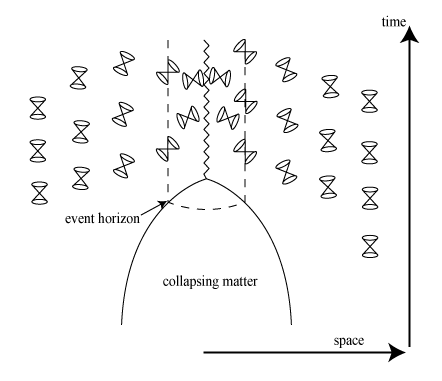Let's start over because I started confusing things with spacelike separation references. I'm certain that Schmelzer and I (and I hope everyone else) agree that timelike separated events are well ordered and not up for interpretation. It's simply a mathematical fact that the creation and growth of a black hole exists in
nobody's past light cones. This is true of all observers AND all observers making judgments about all other observers (which is why I confusingly brought in the spacelike separation issue). Look at the light cones of every point (i.e. potential observers) in this diagram. You can see, visually, that the past light cones tilt to perfectly coincide with the creation of the event horizon.
If a
persistent object A, such as a black hole, is said to coexist with us as observers then we would expect a time to pass such that A's history comes into our past light cone. In other words, the event horizon exists for us today even less than Christmas Day 2100, because Christmas Day 2100 will enter our past light cones eventually.
Nice diagram! The illustration is a quarter section sliver of a black hole event horizon, and various light cones for different observers some distance from where the EH has formed.
This illustrates exactly the point I was trying to make about light cones and event horizons. If light is bending around a black hole (without being captured in its event horizon, obviously, some observers somewhere will be able to notice those in their "world lines" against the edges of the cones defined by the propagation of light reaching them from the vicinity of the black hole.
I understand that for as long as the black hole persists temporally, eventually light from near it (or skirting the black hole) can reach almost any point in the known universe, subject only to constraints imposed by the speed of light and the location of the BH.
In this respect, the black hole is no different from a black box. The only way we could be assured of detecting its presence would be by means of a partial eclipse (it would hide or gravitationally lens the stars and galaxies behind it until they cleared the field).
This tells us exactly nothing about what is going on inside of the EH, and the light cones don't really help the model conceptually either. Time dilates in the vicinity of the BH gravitational field, which is the reason light appears to bend around it.
As to whether or not the light cones "really" extend into "the past" where the black hole collapsed, this has no real meaning for light cones anyway. In Minkowski's universe, time was still an absolute, anchored to covariant remnants of a geometry of absolute space by means of the Pythagorean theorem, complex numbers, and invariant 4D "intervals" for vectors in 4D spacetime. Vectors in relativistic space don't add like vectors in the Euclidean geometry of solids that never move. Space doesn't "warp" like a 4D version of a 2D rubber sheet because there is no inertia nor absolute origin anchored in space comprised of three dimensions of inertialess light travel time. The only vector geometrical relationship that works in relativistic space is to add +c to -c in diametrically opposite directions to obtain exactly what "at rest", or v=zero means, for any inertial reference frame. Minkowski's simultaneity was not the same simultaneity we understand derives of quantum entanglement. And none of the relationships he put forward to explain simultaneity in relativity make any sense for REAL simultaneity that derives of entanglement, because this simultaneity even outruns the speed of light.
Calculating 4D intervals to determine the 4D distance vectors between quantum entangled events (faster than c) makes exactly no sense at all, in any version of the math Minkowski proposed, yet this is EXACTLY what he meant by the term "simultaneity" in relativity. I can't make the argument against using light cones or anything else Minkowski proposed any stronger than that. It isn't likely to provide insight into the goings on inside of a BH, at any rate.
Physicsforums has a lively discussion of this:
https://www.physicsforums.com/threa...lement-and-relativity-of-simultaneity.633942/
And I have adopted no point of view expressed there. The respective languages of QM and relativity are both sorely in need of a revision that makes them consistent with each other. Dropping Minkowski's 4D spacetime altogether is the quickest way I can see to resolve the problem. You don't need Lorentz covariance, 4D intervals, Minkowski rotation, spacetime warpage, or light cones. Time dilation and relativity all by itself works just fine to describe the dynamics of quantum entanglement and bulk energy propagation in three dimensions, all of which are light travel time.


